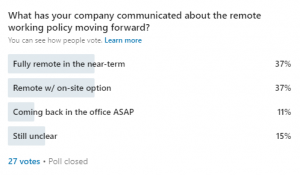You’ve heard us say this before: The Future of Work is now.
When the pandemic started, many businesses felt as if they were thrust into an experiment of sorts with what was previously in-office talent now dispersed in remote locations, some even electing to move to the relative safe haven of a more suburban or rural living environment for health and safety reasons.
Months later, it seems more and more that remote will serve as the new way of operating for many. We even ran our own poll on LinkedIn to see what people would say in regards to how their company has communicated what the plans are in the immediate and near-term future. Despite a small sample size, the results were equal parts astounding but unsurprising:
Approximately 75% of respondents noted that remote would be central to the way that their company would operate for now. This presents a unique set of challenges that traditional IT simply just doesn’t cater to well. Modern workflows and antiquated systems and processes make for a messy experience fraught with issues for both end users and those tasked with supporting those end users.
In a traditional IT ecosystem where your company is reliant on physical devices, you’ll have a “square peg, round hole” strategy for navigating the current environment. Why?
- Inventory tracking and implications. Irrespective of the size of your company, someone (or several people) can/should be tasked with being able to inventory your hardware. You’d want to accomplish this in order to maintain optimal performance, push security patches and updates in a timely fashion, and forecast refresh cycles of said hardware so that the company is getting out in front of any hardware investments needed in the future.
- Placing a token in the financial merry go-round. In today’s state of IT hardware in general, we see a rapid rate of obsolescence. More often than not, the devices of today just won’t be sufficient tomorrow. This means companies that are reliant on hardware are consistently investing and reinvesting capital into purchasing of hardware for their end users, which can get really expensive in a hurry.
- Data security risks. Storing data and having processes operate locally on devices is more dangerous than ever as folks work remotely. Being reliant on physical devices make this even more challenging – and in many cases nearly impossible.
Virtual workspaces, like that provided by MagicDesk are one of the ways that companies across industries are seeking out in order to solve for these types of issues. Here’s how:
Centralization of Management.
Working with a solution provider like us creates a single source of truth to how the desktop environment of your business is managed. We mean this in terms of support and where the workspaces live. From a support standpoint, you’ll work closely with a team of seasoned IT pros for a customizable setup and deployment through ongoing support on a day-to-day basis. Additionally, by virtualizing the workspaces, the computing resources live in a secure location which is then accessed via “dummy terminals” by your end users.
Saving Money.
Trade the CapEx associated with consistently refreshing hardware such as laptops, desktops, and even servers to a predictable, low-cost OpEx model like ours, without sacrificing security, know-how, and the experience for your end users. A simple way to think about this is comparing buying a car to leasing a car. Rather than pay more AND be responsible for upgrades, fixes, support, and maintenance, you can dramatically reduce your costs while working on the newest technologies.
Enhanced Security.
Virtual workspaces = Zero storage or computing resources happening locally on a device. Instead, everything operates and is stored in the secure data center that’s fully managed by our team of experts.
Stay tuned for more examples of why companies are trading in traditional IT for MagicDesk.
Contact our team to learn more at:
212-660-6404 or hello@magicdesk.io


Recent Comments